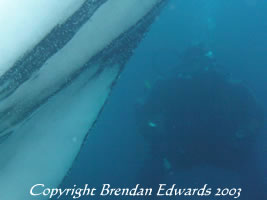One of the first questions people will ask often when you tell them that you will be Scuba Diving in Antarctica, after how cold was it?; will be : What did you see?

I was told I would see similar things to Port Philip Bay in Victoria - just Bigger! The sea life is similar to Southern Ocean diving off the coast of Australia. Sponges, Starfish, some with 30 arms, Shellfish are numerous and Kelp is very lush. Actual Fish Life seemed scarce when we were there, but it was around.
Anemones
Usually 2-5cm across on most of my previous dives, Antarctica showed me this is one place the size of something really is BIG !An anemone we saw on one of our dives was at least 20-25cm across and maybe 40cm tall. It really was an impressive sight.

Shellfish
Small molluscs can be seen in most dives sites and some sea slugs.

Ice Bergs
One of the attractions of Scuba Diving in Antarctica has to be The Bergs. They vary in size, texture, density and colour. Some rest on the sea bed in shallower waters. Some float freely. Some have darkened streaks through from the glacial movements they came from. Caution must be taken when diving around these large blocks of ice because they are dynamic and can shift with the wind, tides and melting.



- Photo1. Ice Berg Textures up close.
- Photo 2. At 25 metres, looking down the face of a berg with the discolouration from Algae
- Photo 3. Shows dirt from the glacial path as it made its way to the oceans.
Visibility
Time of year, dive site and local bird populations will affect the visibility of each dive. Our dive trip was at the Start of the Summer season so Plankton and Algae growth on the icebergs affected our visibility. Later in the year at the end of the Penguin breeding season, the run off from Penguin poo will be a major factor.

Relatively Poor Visibility due to algae and plankton.
Penguins
These critters are very curious and agile in the water and some divers said they saw them on at least one dive.
Seals
We didn't dive with any Seals but they were never really all that far away. Stay clear of the male Bull seals.
